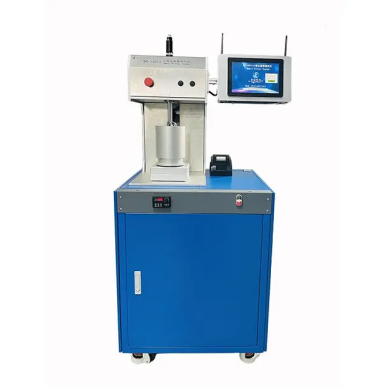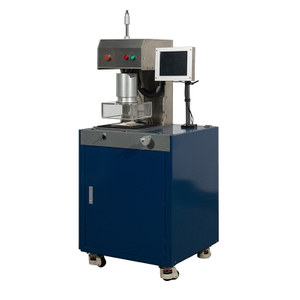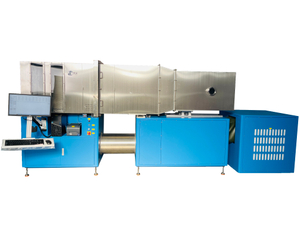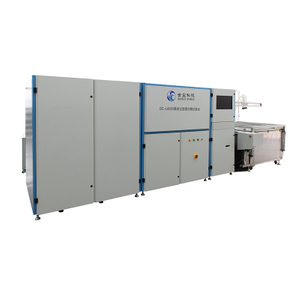The Crucial Role of Aerosol Concentration Control in Detection
The Significance of Aerosol Detection in Filter Product Performance Evaluation
Aerosol detection is a fundamental aspect of evaluating the performance of filter products. Filters are designed to capture and retain particulate matter suspended in aerosols, making accurate assessment of aerosol characteristics essential. In applications ranging from air purification systems to industrial exhaust treatment, the ability of filters to handle aerosols of varying compositions and concentrations directly determines their effectiveness. For instance, in an air - conditioning system, the filter's performance in removing airborne pollutants from aerosols affects the air quality and the health of occupants. Thus, precise aerosol detection provides critical insights into a filter's filtration efficiency, penetration rate, and overall functionality.
The Impact of Unstable Aerosol Concentration on Detection Accuracy
Unstable aerosol concentration can severely compromise the accuracy of filter product detection. Fluctuations in aerosol concentration during testing can lead to inconsistent results, making it difficult to accurately assess a filter's performance. If the concentration is too high, it may overload the filter, causing premature clogging and inaccurate representation of its normal operating capacity. Conversely, a too - low concentration may not fully challenge the filter, resulting in an overestimation of its performance. Moreover, sudden changes in concentration can introduce errors in data collection and analysis, rendering the test results unreliable and potentially leading to incorrect conclusions about the filter's quality.
Introduction to the Technical Feature of Filter Tester: Intelligent Concentration Adjustment with Laskin Nozzle
To address the challenges posed by unstable aerosol concentrations, Scince Purge Technology (Qingdao) Co., Ltd.'s Filter Tester is equipped with an advanced Laskin nozzle, enabling intelligent concentration adjustment. This innovative technology offers a solution that ensures consistent and accurate aerosol concentrations during testing, thereby enhancing the reliability and precision of filter product evaluation. The integration of the Laskin nozzle represents a significant advancement in the field of filter testing, setting the Filter Tester apart from traditional testing equipment.

Technical Principles and Structure of Laskin Nozzle
Working Principle of Laskin Nozzle
Physical Process of Generating Uniform Aerosols through the Porous Structure
The Laskin nozzle operates on the principle of creating a uniform aerosol through its unique porous structure. When a gas stream passes through the nozzle, it encounters a series of precisely arranged small holes. As the gas accelerates through these holes, it shears a liquid or solid material into fine particles, forming an aerosol. The key to its effectiveness lies in the uniform distribution of gas flow across the holes, which ensures that the particles are generated with consistent size and concentration. This process results in a highly homogeneous aerosol, ideal for accurate filter testing.
Pressure Change and Particle Dispersion Mechanism during Gas Flow through the Nozzle
As the gas flows through the Laskin nozzle, there is a significant pressure drop across the porous structure. The pressure difference between the inlet and outlet of the nozzle drives the gas flow and plays a crucial role in particle dispersion. The high - velocity gas exiting the holes creates a turbulent environment, which breaks up the liquid or solid material into smaller particles. The pressure change also affects the flow rate and velocity distribution of the gas, influencing the size and distribution of the generated aerosol particles. By carefully controlling these factors, the Laskin nozzle can produce aerosols with predictable and consistent characteristics.
Structural Design Features
Precise Structure of Laskin Nozzle
The Laskin nozzle features a highly precise structure, with carefully engineered hole sizes and arrangements. The diameter of each hole is typically in the range of a few micrometers to a few millimeters, depending on the application requirements. The holes are usually arranged in a circular or grid pattern to ensure uniform gas distribution. The spacing between the holes is optimized to balance gas flow and particle generation efficiency. This precise design is critical for achieving consistent aerosol production and concentration control.
Guarantee of Aerosol Concentration Stability by Special Structural Design
The unique structural design of the Laskin nozzle significantly contributes to the stability of aerosol concentration. The uniform gas flow distribution across the holes ensures that the aerosol is generated at a consistent rate, minimizing fluctuations in concentration. The carefully calculated hole size and spacing also prevent the formation of large - scale turbulence or flow irregularities that could disrupt the aerosol generation process. As a result, the Laskin nozzle can maintain a stable aerosol concentration over extended periods, providing a reliable testing environment for filter products.
Materials and Manufacturing Processes
High - Quality Materials and Their Performance Advantages
The Laskin nozzle is fabricated using high - quality materials chosen for their excellent performance characteristics. Corrosion - resistant materials, such as stainless steel or special engineering plastics, are commonly used to withstand the harsh conditions during aerosol generation, including exposure to chemicals and high - velocity gas flows. These materials offer good mechanical strength, durability, and resistance to wear and tear, ensuring the long - term reliability of the nozzle. Additionally, materials with low surface roughness are preferred to prevent particle adhesion and ensure smooth gas flow, further enhancing the nozzle's performance.
Importance of High - Precision Manufacturing Processes for Nozzle Performance Consistency
High - precision manufacturing processes are essential for maintaining the performance consistency of the Laskin nozzle. Advanced machining techniques, such as micro - machining and electro - discharge machining, are employed to fabricate the nozzle with extremely tight tolerances. The precise control of hole dimensions, surface finish, and overall geometry is crucial for achieving the desired aerosol generation characteristics. Any deviation in the manufacturing process can lead to variations in gas flow and particle generation, resulting in inconsistent aerosol concentrations. Therefore, strict quality control measures are implemented during the manufacturing process to ensure that each Laskin nozzle meets the highest performance standards.
Realization of Automatic Concentration Adjustment Function
Sensors and Control System
Types and Working Principles of Sensors for Monitoring Aerosol Concentration
The Filter Tester is equipped with advanced sensors to monitor aerosol concentration accurately. Optical particle counters are commonly used, which work based on the principle of light scattering. When an aerosol particle passes through a light - beam, it scatters the light, and the intensity of the scattered light is proportional to the particle size and concentration. Another type of sensor is the electrical aerosol detector, which measures the electrical charge carried by aerosol particles. These sensors can provide real - time data on aerosol concentration with high sensitivity and accuracy, enabling precise monitoring during the testing process.
How the Control System Adjusts Laskin Nozzle Parameters in Real - Time Based on Sensor Data
The control system of the Filter Tester uses the data from the aerosol concentration sensors to adjust the parameters of the Laskin nozzle in real - time. It continuously compares the measured concentration with the pre - set target value. If the concentration deviates from the desired level, the control system calculates the necessary adjustments to parameters such as gas flow rate, liquid feed rate (if applicable), or the operating pressure of the nozzle. These adjustments are then sent to the relevant actuators, which modify the nozzle's operation to bring the aerosol concentration back to the target value. This closed - loop control system ensures that the aerosol concentration remains stable throughout the testing process.
Intelligent Adjustment Algorithms
Logic and Optimization Strategies of Concentration Adjustment Algorithms
The concentration adjustment algorithms employed in the Filter Tester are designed with advanced logic and optimization strategies. They use mathematical models and control theories to predict the impact of parameter adjustments on aerosol concentration. For example, proportional - integral - derivative (PID) control algorithms are often utilized to achieve a rapid and stable response to concentration changes. These algorithms can adapt to different testing scenarios and filter product requirements, optimizing the adjustment process to minimize overshoot and settling time. Additionally, machine - learning - based algorithms can be used to continuously improve the adjustment accuracy based on historical data.
Demonstration of the System's Rapid Adjustment Ability under Different Initial Concentrations and Testing Requirements
The Filter Tester's intelligent adjustment system demonstrates remarkable adaptability under various conditions. Whether the initial aerosol concentration is high or low, or the testing requirements demand a specific concentration range, the system can quickly adjust the Laskin nozzle parameters to reach and maintain the desired concentration. For instance, when switching between different filter types that require different aerosol concentrations for testing, the system can re - calibrate and adjust the nozzle within a short time frame, ensuring seamless transitions between tests and maintaining high - quality test results.
Verification of Concentration Stability
Laboratory Test Data Comparison: Concentration Fluctuations between Laskin Nozzle and Traditional Nozzles
Laboratory tests have shown significant differences in concentration stability between the Laskin nozzle and traditional nozzles. Traditional nozzles often exhibit large fluctuations in aerosol concentration over time, with variations of up to ±20% in some cases. In contrast, the Laskin nozzle maintains a much more stable concentration, with fluctuations typically within ±5%. These data clearly demonstrate the superiority of the Laskin nozzle in providing a consistent testing environment, which is essential for accurate filter product evaluation.
Concentration Maintenance Effect during Long - Term Continuous Detection
During long - term continuous detection, the Laskin nozzle continues to perform exceptionally well in maintaining stable aerosol concentrations. Even after hours of operation, the concentration remains within the acceptable range, without significant drift or degradation. This long - term stability ensures that filter products can be tested thoroughly and accurately, providing reliable data for quality control and performance assessment.
Collaborative Work with High - Precision Detection Instruments
Imported Differential Pressure Transmitters and Laser Particle Counters
Measurement Accuracy and Stability Advantages of High - Precision Imported Differential Pressure Transmitters
The Filter Tester is equipped with high - precision imported differential pressure transmitters, which offer outstanding measurement accuracy and stability. These transmitters can measure pressure differences with an accuracy of up to ±0.1% of the full - scale range. They are designed to withstand harsh industrial environments, with high - quality sensors and robust signal processing circuits. The stability of these transmitters ensures consistent and reliable pressure measurement during filter testing, which is crucial for evaluating the filter's pressure drop characteristics.
Detection Principles and Performance Characteristics of High - Precision Laser Particle Counters
High - precision laser particle counters used in the Filter Tester operate on the principle of laser light scattering. When aerosol particles pass through the laser beam, they scatter the light, and the scattered light is detected by photodetectors. By analyzing the intensity and pattern of the scattered light, the particle counter can determine the size and number of particles in the aerosol. These counters offer high sensitivity, capable of detecting particles as small as a few nanometers in diameter, and excellent repeatability, ensuring accurate and consistent particle counting during filter testing.
Collaborative Enhancement of Detection Accuracy
Cooperation Mechanism among Laskin Nozzle, Differential Pressure Transmitter, and Laser Particle Counter
The Laskin nozzle, differential pressure transmitter, and laser particle counter work in harmony to enhance detection accuracy. The Laskin nozzle generates a stable and uniform aerosol for testing. The differential pressure transmitter measures the pressure drop across the filter, providing information about the filter's resistance and efficiency. The laser particle counter analyzes the aerosol before and after passing through the filter to determine the filtration efficiency. The data from these instruments are integrated and analyzed by the Filter Tester's control system, which uses the information to make comprehensive evaluations of the filter's performance.
High - Precision and Reliable Data of Detection Results
The collaborative work of these three components results in highly precise and reliable detection data. By combining the stable aerosol generation of the Laskin nozzle, accurate pressure measurement of the differential pressure transmitter, and sensitive particle counting of the laser particle counter, the Filter Tester can provide detailed and accurate information about a filter's performance. The integrated data analysis ensures that all aspects of the filter's operation are considered, leading to more comprehensive and trustworthy test results.
Conclusion
In conclusion, the Laskin nozzle endows the Filter Tester with intelligent aerosol concentration adjustment capabilities, which are crucial for accurate filter product testing. The precise control of aerosol concentration not only improves the reliability of detection results but also enhances the overall quality assessment of filter products. By integrating with high - precision detection instruments, the Filter Tester provides a comprehensive and accurate testing solution. For more detailed technical information about this innovative technology, please feel free to consult Scince Purge Technology (Qingdao) Co., Ltd.





















